Healthcare Research Assignment: Ethical Considerations and Methods
VerifiedAdded on 2022/10/09
|7
|1450
|11
Homework Assignment
AI Summary
This assignment delves into the multifaceted world of healthcare research, encompassing both qualitative and quantitative methodologies, ethical considerations, and the imperative of protecting human subjects. It explores the roles of key organizations like the OHRP, CDC, WHO, AHRQ, and IRB in safeguarding research participants and ensuring ethical conduct. The assignment examines the historical context of research abuses, emphasizing the principles of respect for persons, beneficence, and justice. It further addresses the complexities of vulnerable populations, informed consent, and the assessment of risks and benefits in research. Finally, it discusses the ethical implications of incentives in research compensation, highlighting the importance of unbiased decision-making by participants. The document concludes by emphasizing the crucial role of research in advancing knowledge and the need for strict adherence to ethical guidelines when using human subjects.
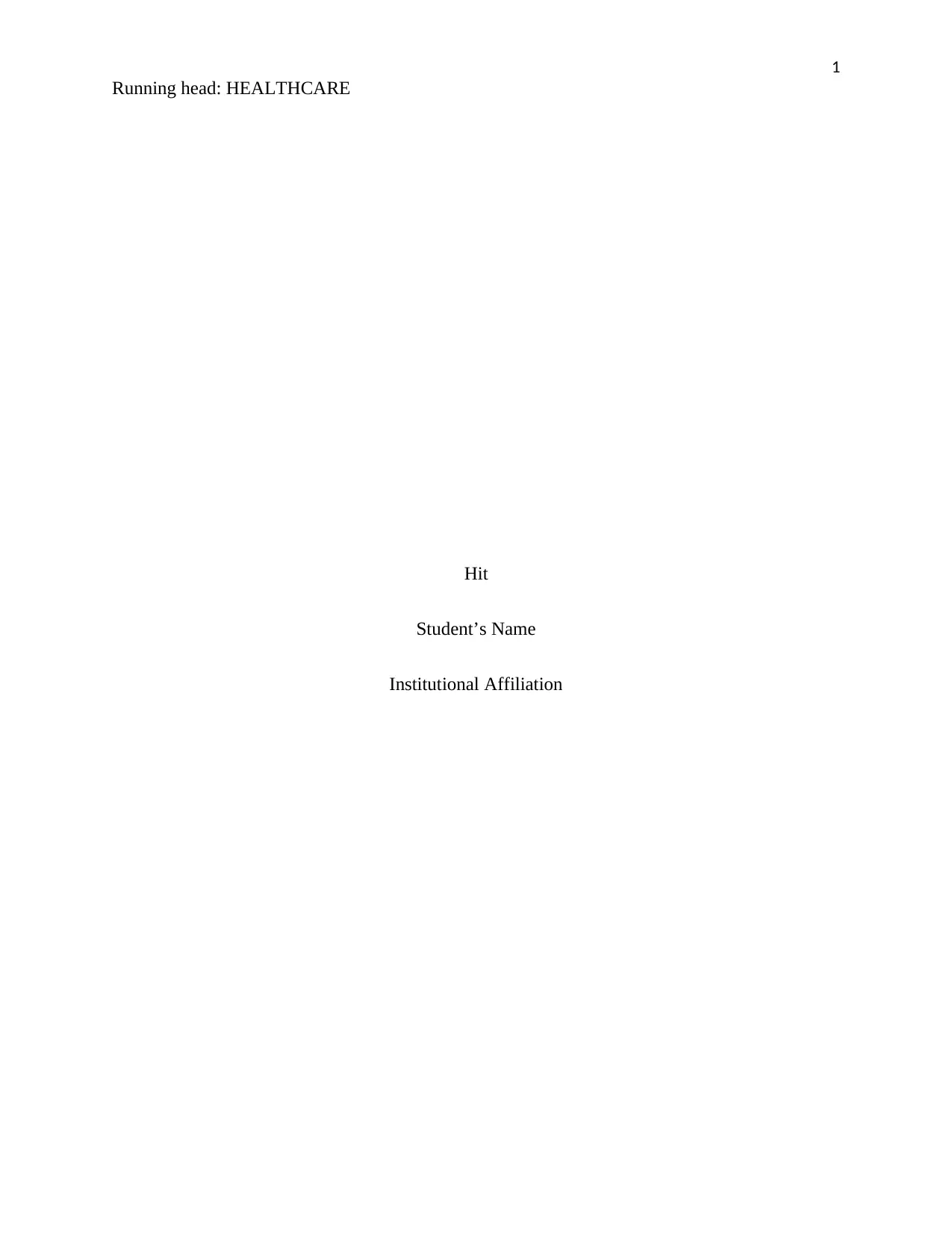
1
Running head: HEALTHCARE
Hit
Student’s Name
Institutional Affiliation
Running head: HEALTHCARE
Hit
Student’s Name
Institutional Affiliation
Paraphrase This Document
Need a fresh take? Get an instant paraphrase of this document with our AI Paraphraser
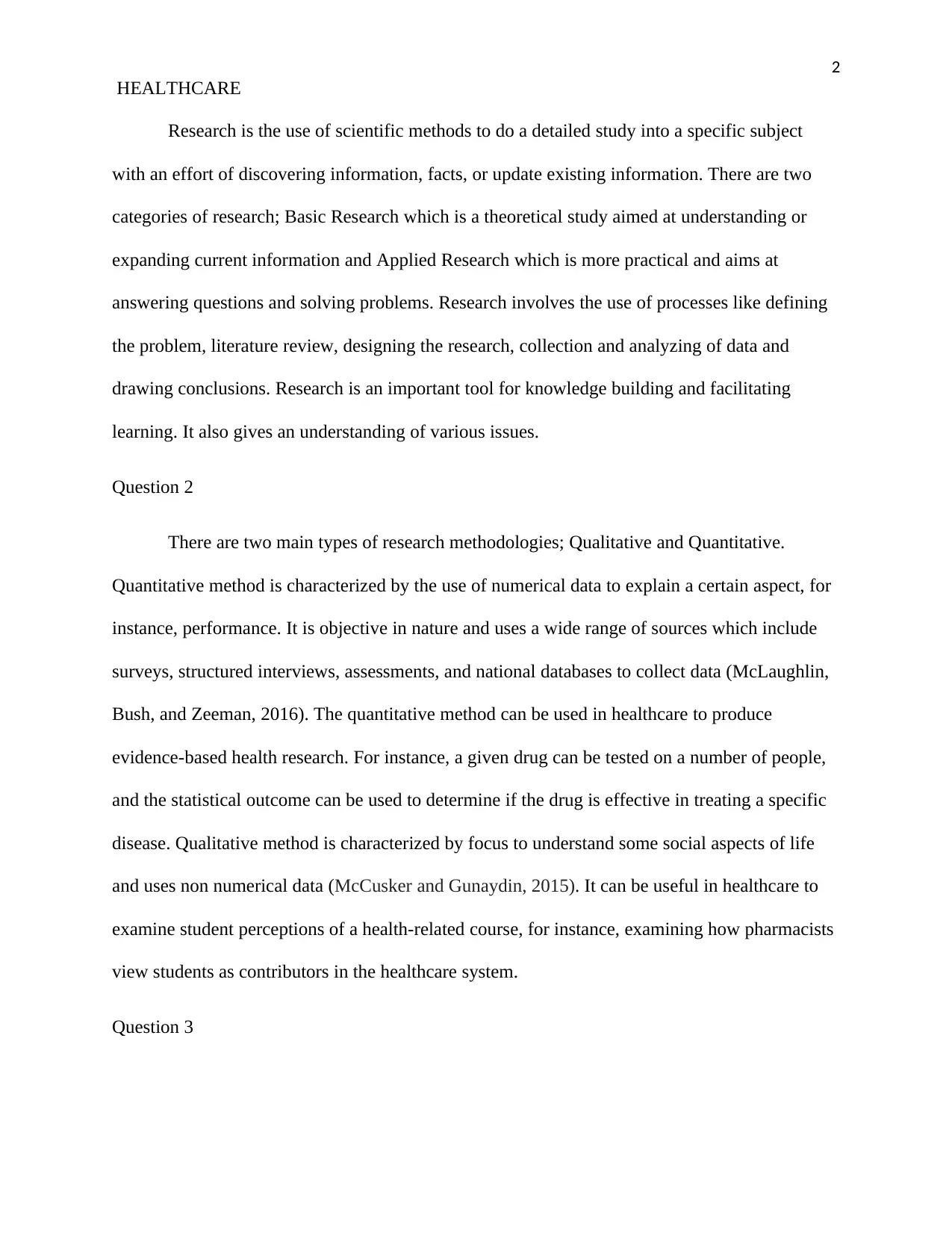
2
HEALTHCARE
Research is the use of scientific methods to do a detailed study into a specific subject
with an effort of discovering information, facts, or update existing information. There are two
categories of research; Basic Research which is a theoretical study aimed at understanding or
expanding current information and Applied Research which is more practical and aims at
answering questions and solving problems. Research involves the use of processes like defining
the problem, literature review, designing the research, collection and analyzing of data and
drawing conclusions. Research is an important tool for knowledge building and facilitating
learning. It also gives an understanding of various issues.
Question 2
There are two main types of research methodologies; Qualitative and Quantitative.
Quantitative method is characterized by the use of numerical data to explain a certain aspect, for
instance, performance. It is objective in nature and uses a wide range of sources which include
surveys, structured interviews, assessments, and national databases to collect data (McLaughlin,
Bush, and Zeeman, 2016). The quantitative method can be used in healthcare to produce
evidence-based health research. For instance, a given drug can be tested on a number of people,
and the statistical outcome can be used to determine if the drug is effective in treating a specific
disease. Qualitative method is characterized by focus to understand some social aspects of life
and uses non numerical data (McCusker and Gunaydin, 2015). It can be useful in healthcare to
examine student perceptions of a health-related course, for instance, examining how pharmacists
view students as contributors in the healthcare system.
Question 3
HEALTHCARE
Research is the use of scientific methods to do a detailed study into a specific subject
with an effort of discovering information, facts, or update existing information. There are two
categories of research; Basic Research which is a theoretical study aimed at understanding or
expanding current information and Applied Research which is more practical and aims at
answering questions and solving problems. Research involves the use of processes like defining
the problem, literature review, designing the research, collection and analyzing of data and
drawing conclusions. Research is an important tool for knowledge building and facilitating
learning. It also gives an understanding of various issues.
Question 2
There are two main types of research methodologies; Qualitative and Quantitative.
Quantitative method is characterized by the use of numerical data to explain a certain aspect, for
instance, performance. It is objective in nature and uses a wide range of sources which include
surveys, structured interviews, assessments, and national databases to collect data (McLaughlin,
Bush, and Zeeman, 2016). The quantitative method can be used in healthcare to produce
evidence-based health research. For instance, a given drug can be tested on a number of people,
and the statistical outcome can be used to determine if the drug is effective in treating a specific
disease. Qualitative method is characterized by focus to understand some social aspects of life
and uses non numerical data (McCusker and Gunaydin, 2015). It can be useful in healthcare to
examine student perceptions of a health-related course, for instance, examining how pharmacists
view students as contributors in the healthcare system.
Question 3
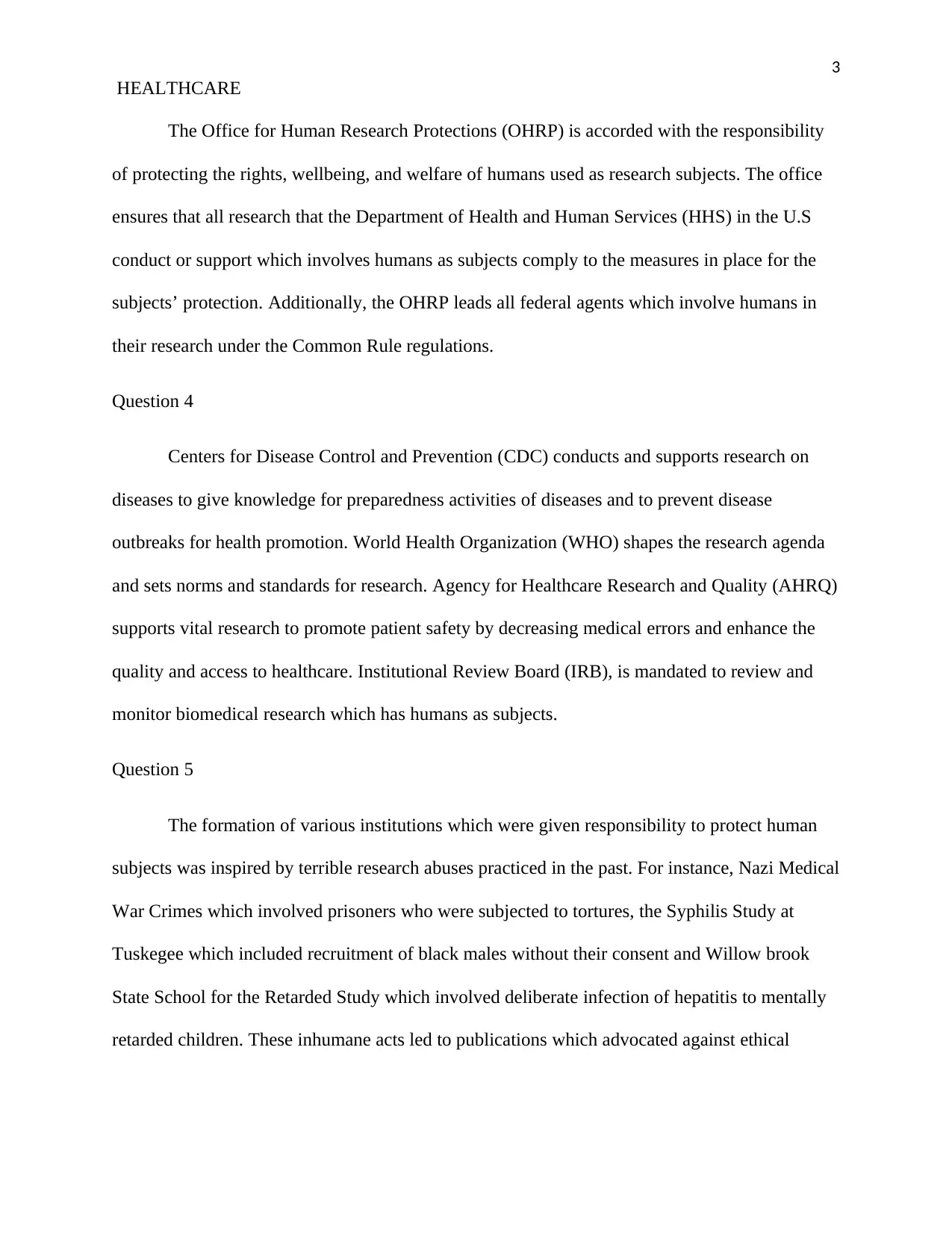
3
HEALTHCARE
The Office for Human Research Protections (OHRP) is accorded with the responsibility
of protecting the rights, wellbeing, and welfare of humans used as research subjects. The office
ensures that all research that the Department of Health and Human Services (HHS) in the U.S
conduct or support which involves humans as subjects comply to the measures in place for the
subjects’ protection. Additionally, the OHRP leads all federal agents which involve humans in
their research under the Common Rule regulations.
Question 4
Centers for Disease Control and Prevention (CDC) conducts and supports research on
diseases to give knowledge for preparedness activities of diseases and to prevent disease
outbreaks for health promotion. World Health Organization (WHO) shapes the research agenda
and sets norms and standards for research. Agency for Healthcare Research and Quality (AHRQ)
supports vital research to promote patient safety by decreasing medical errors and enhance the
quality and access to healthcare. Institutional Review Board (IRB), is mandated to review and
monitor biomedical research which has humans as subjects.
Question 5
The formation of various institutions which were given responsibility to protect human
subjects was inspired by terrible research abuses practiced in the past. For instance, Nazi Medical
War Crimes which involved prisoners who were subjected to tortures, the Syphilis Study at
Tuskegee which included recruitment of black males without their consent and Willow brook
State School for the Retarded Study which involved deliberate infection of hepatitis to mentally
retarded children. These inhumane acts led to publications which advocated against ethical
HEALTHCARE
The Office for Human Research Protections (OHRP) is accorded with the responsibility
of protecting the rights, wellbeing, and welfare of humans used as research subjects. The office
ensures that all research that the Department of Health and Human Services (HHS) in the U.S
conduct or support which involves humans as subjects comply to the measures in place for the
subjects’ protection. Additionally, the OHRP leads all federal agents which involve humans in
their research under the Common Rule regulations.
Question 4
Centers for Disease Control and Prevention (CDC) conducts and supports research on
diseases to give knowledge for preparedness activities of diseases and to prevent disease
outbreaks for health promotion. World Health Organization (WHO) shapes the research agenda
and sets norms and standards for research. Agency for Healthcare Research and Quality (AHRQ)
supports vital research to promote patient safety by decreasing medical errors and enhance the
quality and access to healthcare. Institutional Review Board (IRB), is mandated to review and
monitor biomedical research which has humans as subjects.
Question 5
The formation of various institutions which were given responsibility to protect human
subjects was inspired by terrible research abuses practiced in the past. For instance, Nazi Medical
War Crimes which involved prisoners who were subjected to tortures, the Syphilis Study at
Tuskegee which included recruitment of black males without their consent and Willow brook
State School for the Retarded Study which involved deliberate infection of hepatitis to mentally
retarded children. These inhumane acts led to publications which advocated against ethical
⊘ This is a preview!⊘
Do you want full access?
Subscribe today to unlock all pages.

Trusted by 1+ million students worldwide
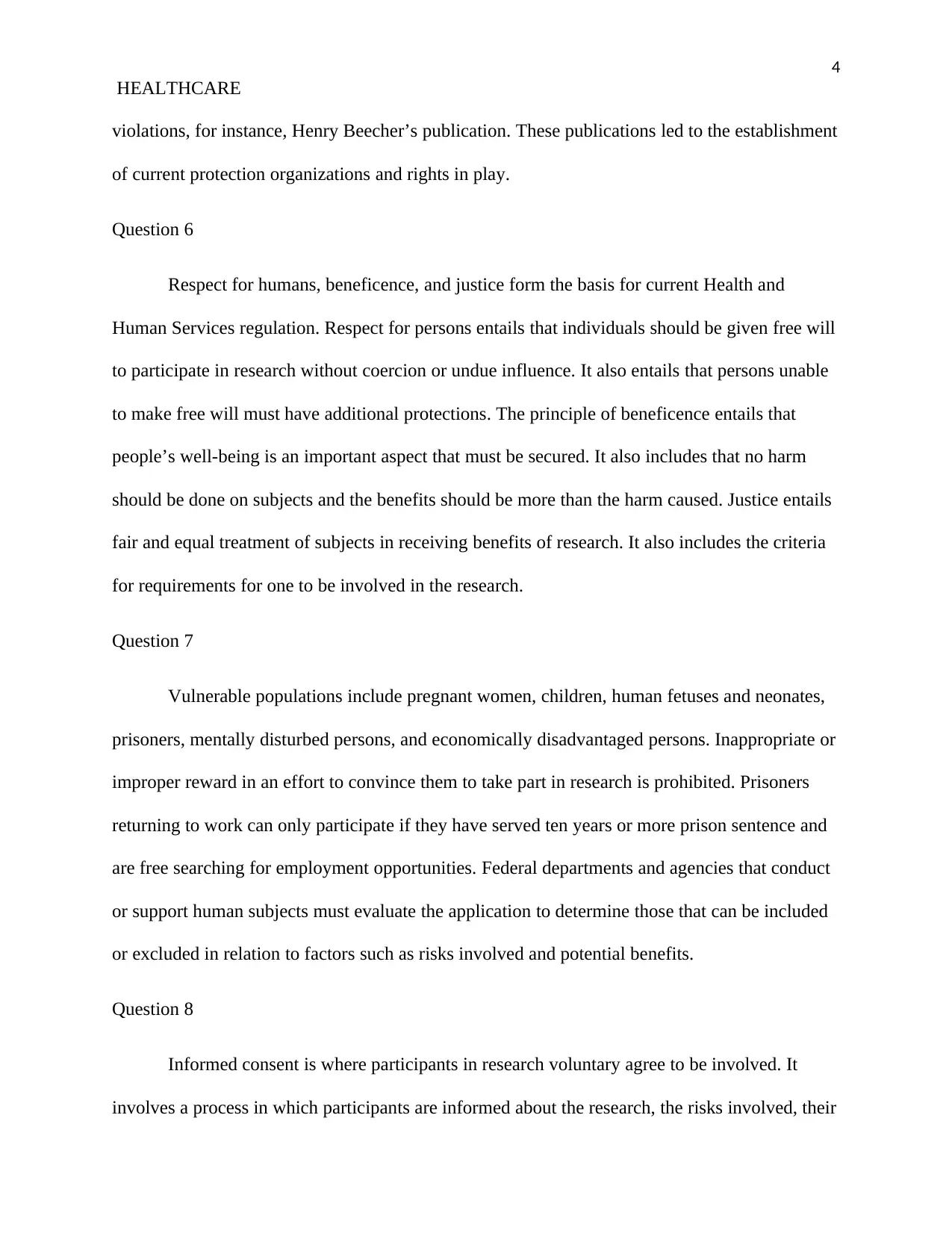
4
HEALTHCARE
violations, for instance, Henry Beecher’s publication. These publications led to the establishment
of current protection organizations and rights in play.
Question 6
Respect for humans, beneficence, and justice form the basis for current Health and
Human Services regulation. Respect for persons entails that individuals should be given free will
to participate in research without coercion or undue influence. It also entails that persons unable
to make free will must have additional protections. The principle of beneficence entails that
people’s well-being is an important aspect that must be secured. It also includes that no harm
should be done on subjects and the benefits should be more than the harm caused. Justice entails
fair and equal treatment of subjects in receiving benefits of research. It also includes the criteria
for requirements for one to be involved in the research.
Question 7
Vulnerable populations include pregnant women, children, human fetuses and neonates,
prisoners, mentally disturbed persons, and economically disadvantaged persons. Inappropriate or
improper reward in an effort to convince them to take part in research is prohibited. Prisoners
returning to work can only participate if they have served ten years or more prison sentence and
are free searching for employment opportunities. Federal departments and agencies that conduct
or support human subjects must evaluate the application to determine those that can be included
or excluded in relation to factors such as risks involved and potential benefits.
Question 8
Informed consent is where participants in research voluntary agree to be involved. It
involves a process in which participants are informed about the research, the risks involved, their
HEALTHCARE
violations, for instance, Henry Beecher’s publication. These publications led to the establishment
of current protection organizations and rights in play.
Question 6
Respect for humans, beneficence, and justice form the basis for current Health and
Human Services regulation. Respect for persons entails that individuals should be given free will
to participate in research without coercion or undue influence. It also entails that persons unable
to make free will must have additional protections. The principle of beneficence entails that
people’s well-being is an important aspect that must be secured. It also includes that no harm
should be done on subjects and the benefits should be more than the harm caused. Justice entails
fair and equal treatment of subjects in receiving benefits of research. It also includes the criteria
for requirements for one to be involved in the research.
Question 7
Vulnerable populations include pregnant women, children, human fetuses and neonates,
prisoners, mentally disturbed persons, and economically disadvantaged persons. Inappropriate or
improper reward in an effort to convince them to take part in research is prohibited. Prisoners
returning to work can only participate if they have served ten years or more prison sentence and
are free searching for employment opportunities. Federal departments and agencies that conduct
or support human subjects must evaluate the application to determine those that can be included
or excluded in relation to factors such as risks involved and potential benefits.
Question 8
Informed consent is where participants in research voluntary agree to be involved. It
involves a process in which participants are informed about the research, the risks involved, their
Paraphrase This Document
Need a fresh take? Get an instant paraphrase of this document with our AI Paraphraser
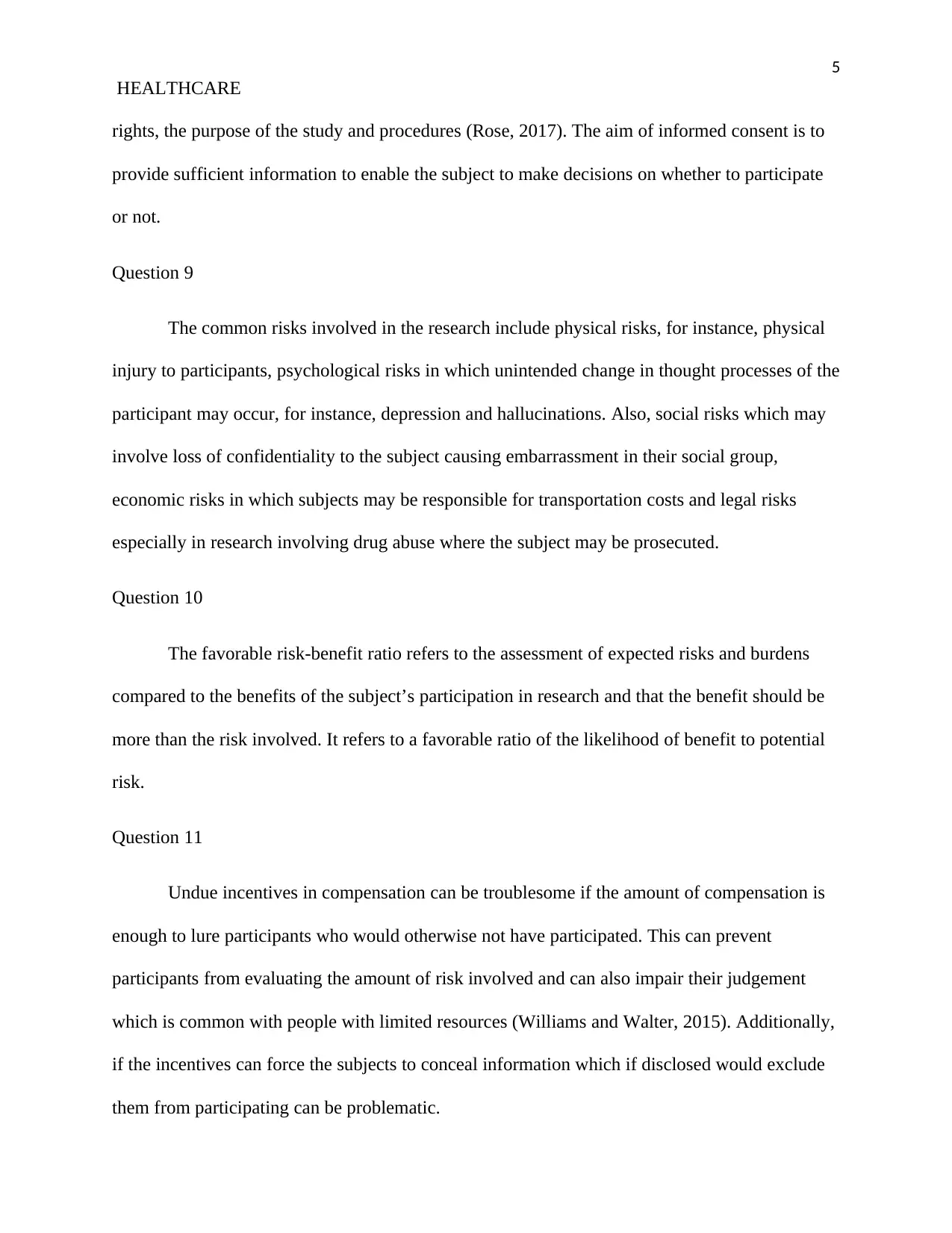
5
HEALTHCARE
rights, the purpose of the study and procedures (Rose, 2017). The aim of informed consent is to
provide sufficient information to enable the subject to make decisions on whether to participate
or not.
Question 9
The common risks involved in the research include physical risks, for instance, physical
injury to participants, psychological risks in which unintended change in thought processes of the
participant may occur, for instance, depression and hallucinations. Also, social risks which may
involve loss of confidentiality to the subject causing embarrassment in their social group,
economic risks in which subjects may be responsible for transportation costs and legal risks
especially in research involving drug abuse where the subject may be prosecuted.
Question 10
The favorable risk-benefit ratio refers to the assessment of expected risks and burdens
compared to the benefits of the subject’s participation in research and that the benefit should be
more than the risk involved. It refers to a favorable ratio of the likelihood of benefit to potential
risk.
Question 11
Undue incentives in compensation can be troublesome if the amount of compensation is
enough to lure participants who would otherwise not have participated. This can prevent
participants from evaluating the amount of risk involved and can also impair their judgement
which is common with people with limited resources (Williams and Walter, 2015). Additionally,
if the incentives can force the subjects to conceal information which if disclosed would exclude
them from participating can be problematic.
HEALTHCARE
rights, the purpose of the study and procedures (Rose, 2017). The aim of informed consent is to
provide sufficient information to enable the subject to make decisions on whether to participate
or not.
Question 9
The common risks involved in the research include physical risks, for instance, physical
injury to participants, psychological risks in which unintended change in thought processes of the
participant may occur, for instance, depression and hallucinations. Also, social risks which may
involve loss of confidentiality to the subject causing embarrassment in their social group,
economic risks in which subjects may be responsible for transportation costs and legal risks
especially in research involving drug abuse where the subject may be prosecuted.
Question 10
The favorable risk-benefit ratio refers to the assessment of expected risks and burdens
compared to the benefits of the subject’s participation in research and that the benefit should be
more than the risk involved. It refers to a favorable ratio of the likelihood of benefit to potential
risk.
Question 11
Undue incentives in compensation can be troublesome if the amount of compensation is
enough to lure participants who would otherwise not have participated. This can prevent
participants from evaluating the amount of risk involved and can also impair their judgement
which is common with people with limited resources (Williams and Walter, 2015). Additionally,
if the incentives can force the subjects to conceal information which if disclosed would exclude
them from participating can be problematic.

6
HEALTHCARE
From the analysis, it is evident that research is an important aspect of society as it is the
source of knowledge. Research that uses human subjects must follow the guidelines provided by
federal organizations. Protection of human subjects is vital as per lessons learned from past
inhumane researches and this is ensured by different organizations mandated with the role. Also,
compensation of human subjects must be ensured and the risks involved well explained so that
one makes uncoerced decision to participate.
HEALTHCARE
From the analysis, it is evident that research is an important aspect of society as it is the
source of knowledge. Research that uses human subjects must follow the guidelines provided by
federal organizations. Protection of human subjects is vital as per lessons learned from past
inhumane researches and this is ensured by different organizations mandated with the role. Also,
compensation of human subjects must be ensured and the risks involved well explained so that
one makes uncoerced decision to participate.
⊘ This is a preview!⊘
Do you want full access?
Subscribe today to unlock all pages.

Trusted by 1+ million students worldwide
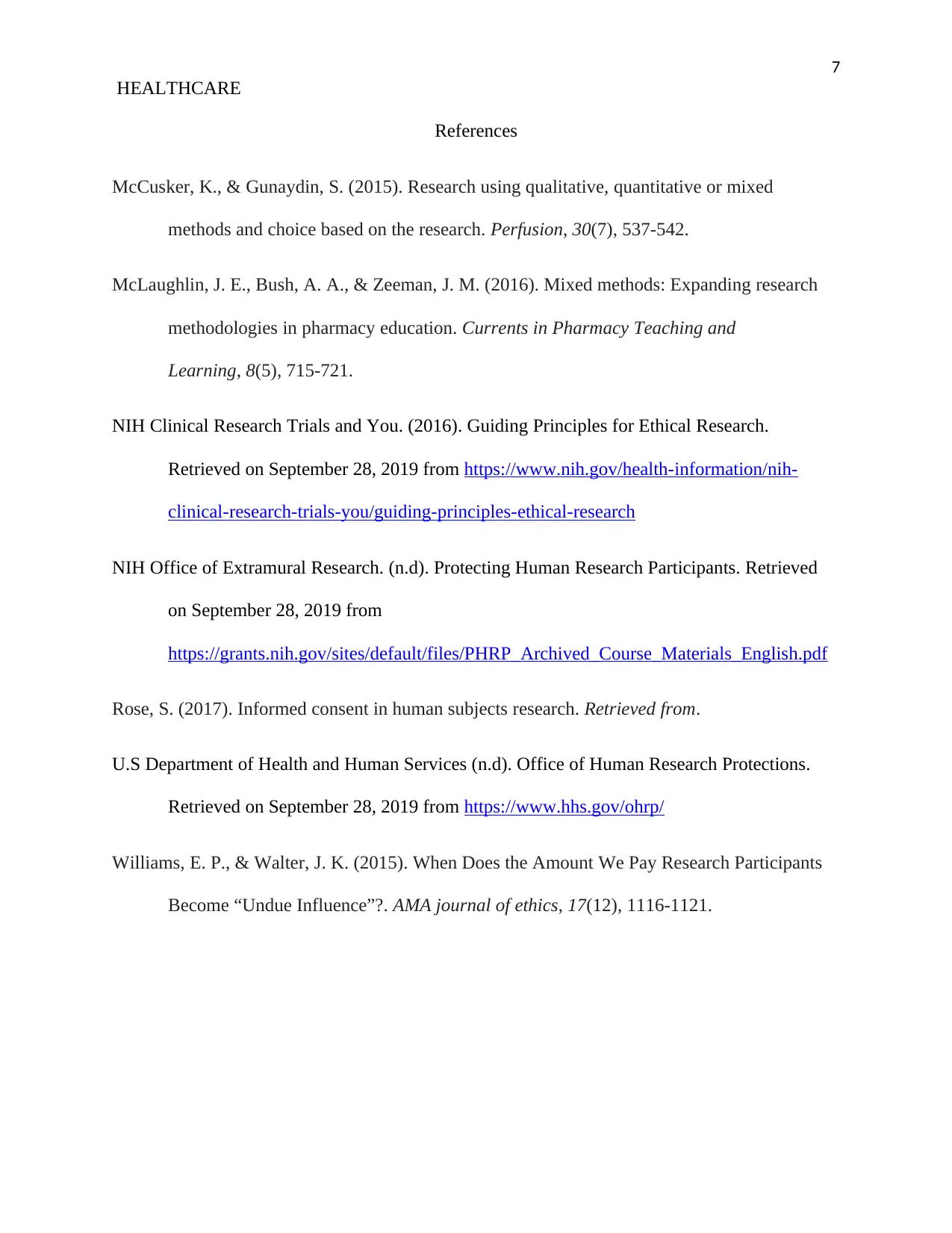
7
HEALTHCARE
References
McCusker, K., & Gunaydin, S. (2015). Research using qualitative, quantitative or mixed
methods and choice based on the research. Perfusion, 30(7), 537-542.
McLaughlin, J. E., Bush, A. A., & Zeeman, J. M. (2016). Mixed methods: Expanding research
methodologies in pharmacy education. Currents in Pharmacy Teaching and
Learning, 8(5), 715-721.
NIH Clinical Research Trials and You. (2016). Guiding Principles for Ethical Research.
Retrieved on September 28, 2019 from https://www.nih.gov/health-information/nih-
clinical-research-trials-you/guiding-principles-ethical-research
NIH Office of Extramural Research. (n.d). Protecting Human Research Participants. Retrieved
on September 28, 2019 from
https://grants.nih.gov/sites/default/files/PHRP_Archived_Course_Materials_English.pdf
Rose, S. (2017). Informed consent in human subjects research. Retrieved from.
U.S Department of Health and Human Services (n.d). Office of Human Research Protections.
Retrieved on September 28, 2019 from https://www.hhs.gov/ohrp/
Williams, E. P., & Walter, J. K. (2015). When Does the Amount We Pay Research Participants
Become “Undue Influence”?. AMA journal of ethics, 17(12), 1116-1121.
HEALTHCARE
References
McCusker, K., & Gunaydin, S. (2015). Research using qualitative, quantitative or mixed
methods and choice based on the research. Perfusion, 30(7), 537-542.
McLaughlin, J. E., Bush, A. A., & Zeeman, J. M. (2016). Mixed methods: Expanding research
methodologies in pharmacy education. Currents in Pharmacy Teaching and
Learning, 8(5), 715-721.
NIH Clinical Research Trials and You. (2016). Guiding Principles for Ethical Research.
Retrieved on September 28, 2019 from https://www.nih.gov/health-information/nih-
clinical-research-trials-you/guiding-principles-ethical-research
NIH Office of Extramural Research. (n.d). Protecting Human Research Participants. Retrieved
on September 28, 2019 from
https://grants.nih.gov/sites/default/files/PHRP_Archived_Course_Materials_English.pdf
Rose, S. (2017). Informed consent in human subjects research. Retrieved from.
U.S Department of Health and Human Services (n.d). Office of Human Research Protections.
Retrieved on September 28, 2019 from https://www.hhs.gov/ohrp/
Williams, E. P., & Walter, J. K. (2015). When Does the Amount We Pay Research Participants
Become “Undue Influence”?. AMA journal of ethics, 17(12), 1116-1121.
1 out of 7
Related Documents
Your All-in-One AI-Powered Toolkit for Academic Success.
+13062052269
info@desklib.com
Available 24*7 on WhatsApp / Email
![[object Object]](/_next/static/media/star-bottom.7253800d.svg)
Unlock your academic potential
Copyright © 2020–2025 A2Z Services. All Rights Reserved. Developed and managed by ZUCOL.




